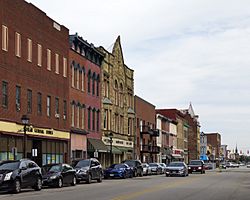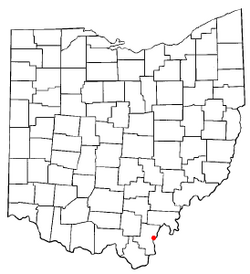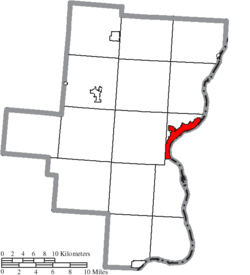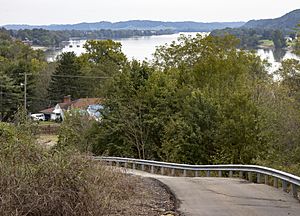Gallipolis, Ohio facts for kids
Quick facts for kids
Gallipolis, Ohio
|
|
|---|---|
|
Village
|
|

Downtown Gallipolis
|
|
| Nickname(s):
City of the Gauls
|
|

Location of Gallipolis, Ohio
|
|

Location of Gallipolis in Gallia County
|
|
| Country | United States |
| State | Ohio |
| County | Gallia |
| Township | Gallipolis |
| Founded | October 17, 1790 |
| Area | |
| • Total | 3.83 sq mi (9.91 km2) |
| • Land | 3.60 sq mi (9.32 km2) |
| • Water | 0.23 sq mi (0.59 km2) |
| Elevation | 571 ft (174 m) |
| Population
(2020)
|
|
| • Total | 3,313 |
| • Estimate
(2023)
|
3,284 |
| • Density | 921.05/sq mi (355.57/km2) |
| Time zone | UTC-5 (Eastern (EST)) |
| • Summer (DST) | UTC-4 (EDT) |
| ZIP code |
45631
|
| Area code(s) | 740 |
| FIPS code | 39-29204 |
| GNIS feature ID | 2398939 |
| Website | Village of Gallipolis website |
Gallipolis (/ˌɡæləpəˈliːs/ GAL-ə-PƏ-leess) is a small town, or village, in Ohio, United States. It is the main town of Gallia County, Ohio. Gallipolis is located in southeastern Ohio, right along the Ohio River. It is about 55 miles (88 km) southeast of Chillicothe. In 2020, about 3,313 people lived there. Gallipolis is sometimes called "The City of the Gauls" because of its French history.
Contents
History of Gallipolis
Early French Settlers
Gallipolis was first settled by Europeans in 1790. A group of about 500 French people, including nobles, business owners, and skilled workers, came here. They were escaping the French Revolution in their home country. Their leader was Count Jean-Joseph de Barth. Gallipolis was the second town founded in the new Northwest Territory of the United States. Because of these first settlers, it is known as "The Old French City."
At that time, many people were trying to buy and sell land in the Northwest Territory. This land had just opened for settlement. The French settlers had paid a company called the Scioto Company for land along the Ohio River. They traveled to the United States and then made their way to Gallipolis. These French people were used to city life. They were surprised by the wild, undeveloped land they found.
Land Challenges and New Beginnings
When the French settlers arrived in Gallipolis, they found out their land deeds were not valid. The Scioto Company did not actually own the land they had sold. Another company, the Ohio Company, had the rights to develop it. Despite this problem, the settlers managed to survive. They built cabins close together in what is now City Park. They also built a fence and towers for defense.
In 1795, President George Washington's government gave the settlers free land. This land was in an area called the French Grant, located in what is now Scioto County, Ohio. To own this land, settlers had to live on it for five years and farm it. Many settlers chose to stay in Gallipolis. They had to buy their land again, this time from the Ohio Company. Most of them either sold their French Grant land or had others farm it for them.
The name Gallipolis comes from two parts: "Galli-" (meaning "French") and "-polis" (meaning "city"). So, Gallipolis means "city of the French." A post office opened in Gallipolis in 1794.
Important Buildings and Events
In 1893, a state hospital for people with epilepsy opened in Gallipolis. It was later renamed the Gallipolis Developmental Center. Today, it still helps people with developmental disabilities in the Appalachian Ohio area.
A major event happened on December 15, 1967. The Silver Bridge, which connected Gallipolis to Point Pleasant, West Virginia, collapsed. This happened during busy traffic and caused 46 deaths. The bridge was built in 1928. Later studies showed it was carrying much heavier loads than it was designed for. It also had not been kept up very well. A new bridge, the Silver Memorial Bridge, was built in 1969 to replace it.
When the number of people living in Gallipolis dropped below 5,000, it officially became a village again under state law. However, it still runs its local government like a city.
Geography and Climate
Where is Gallipolis?
Gallipolis is located along the Ohio River in the Appalachia region. The village covers about 3.83 square miles (9.91 square kilometers). Most of this area is land, with a small part being water. Gallipolis is in the hilly, unglaciated part of southeastern Ohio.

Weather in Gallipolis
Gallipolis has four clear seasons. Summers are hot and humid, while winters are cold and dry. The average temperature in January is about 34.3°F (1.3°C). Snowfall is usually light, with about 10.9 inches (27.7 cm) per year. In summer, the average temperature in July is about 78.6°F (25.9°C). It can get very hot, with temperatures reaching 90°F (32°C) or higher about 39 days a year.
Rainfall is heaviest from late spring to early summer. Gallipolis gets about 40.3 inches (102.4 cm) of rain each year. Like many places in the Midwest, Gallipolis can experience strong thunderstorms. These storms can bring lightning, hail, floods, and even tornadoes. One famous tornado event was the 1968 Wheelersburg tornado outbreak.
| Climate data for Gallipolis, Ohio (1991–2020 normals, extremes 1934–present) | |||||||||||||
|---|---|---|---|---|---|---|---|---|---|---|---|---|---|
| Month | Jan | Feb | Mar | Apr | May | Jun | Jul | Aug | Sep | Oct | Nov | Dec | Year |
| Record high °F (°C) | 79 (26) |
79 (26) |
87 (31) |
93 (34) |
98 (37) |
105 (41) |
113 (45) |
108 (42) |
105 (41) |
96 (36) |
89 (32) |
80 (27) |
113 (45) |
| Mean daily maximum °F (°C) | 41.0 (5.0) |
45.5 (7.5) |
54.7 (12.6) |
67.1 (19.5) |
75.1 (23.9) |
82.9 (28.3) |
86.2 (30.1) |
85.6 (29.8) |
79.8 (26.6) |
68.4 (20.2) |
56.1 (13.4) |
45.4 (7.4) |
65.6 (18.7) |
| Daily mean °F (°C) | 32.1 (0.1) |
35.4 (1.9) |
43.5 (6.4) |
54.4 (12.4) |
63.8 (17.7) |
72.2 (22.3) |
75.9 (24.4) |
74.9 (23.8) |
68.4 (20.2) |
56.6 (13.7) |
45.1 (7.3) |
36.8 (2.7) |
54.9 (12.7) |
| Mean daily minimum °F (°C) | 23.1 (−4.9) |
25.2 (−3.8) |
32.2 (0.1) |
41.7 (5.4) |
52.4 (11.3) |
61.4 (16.3) |
65.7 (18.7) |
64.1 (17.8) |
57.0 (13.9) |
44.8 (7.1) |
34.2 (1.2) |
28.2 (−2.1) |
44.2 (6.8) |
| Record low °F (°C) | −28 (−33) |
−14 (−26) |
−9 (−23) |
16 (−9) |
23 (−5) |
34 (1) |
43 (6) |
39 (4) |
27 (−3) |
15 (−9) |
0 (−18) |
−13 (−25) |
−28 (−33) |
| Average precipitation inches (mm) | 3.07 (78) |
3.08 (78) |
4.05 (103) |
3.92 (100) |
4.48 (114) |
4.61 (117) |
4.47 (114) |
3.55 (90) |
3.75 (95) |
3.12 (79) |
2.63 (67) |
3.80 (97) |
44.53 (1,131) |
| Average precipitation days (≥ 0.01 in) | 12.7 | 11.2 | 11.8 | 12.6 | 12.7 | 11.0 | 10.4 | 8.2 | 8.7 | 9.2 | 10.0 | 12.5 | 131.0 |
| Source: NOAA | |||||||||||||
People and Economy
Population Changes Over Time
The number of people living in Gallipolis has changed a lot over the years. In 1840, there were 1,413 people. The population grew steadily until the 1960s, reaching its highest point of 8,775 in 1960. Since then, the population has slowly decreased. In 2020, it was 3,313.
| Historical population | |||
|---|---|---|---|
| Census | Pop. | %± | |
| 1840 | 1,413 | — | |
| 1850 | 1,686 | 19.3% | |
| 1860 | 3,418 | 102.7% | |
| 1870 | 3,711 | 8.6% | |
| 1880 | 4,400 | 18.6% | |
| 1890 | 4,498 | 2.2% | |
| 1900 | 5,432 | 20.8% | |
| 1910 | 5,560 | 2.4% | |
| 1920 | 6,670 | 20.0% | |
| 1930 | 7,106 | 6.5% | |
| 1940 | 7,833 | 10.2% | |
| 1950 | 7,871 | 0.5% | |
| 1960 | 8,775 | 11.5% | |
| 1970 | 7,490 | −14.6% | |
| 1980 | 5,601 | −25.2% | |
| 1990 | 4,831 | −13.7% | |
| 2000 | 4,180 | −13.5% | |
| 2010 | 3,641 | −12.9% | |
| 2020 | 3,313 | −9.0% | |
| 2023 (est.) | 3,284 | −9.8% | |
| U.S. Decennial Census | |||
Who Lives in Gallipolis?
Based on the 2010 census, there were 3,641 people living in Gallipolis. Most residents, about 89.7%, were White. About 5.1% were African American, and other groups made up smaller percentages. About 1.2% of the population was Hispanic or Latino.
The average age in the village was 44.6 years old. About 18.9% of residents were under 18. About 20.8% were 65 years or older. There were slightly more females (51.7%) than males (48.3%).
Local Businesses and Jobs
Gallipolis is the hometown of Bob Evans, who started the famous Bob Evans Restaurants. His very first restaurant was in nearby Rio Grande, Ohio.
Other important employers in the Gallipolis area include:
- American Electric Power (which runs the Gavin Power Plant)
- Ohio Valley Electric Company (which runs the Kyger Creek Power Plant)
- Holzer Healthcare System
- University of Rio Grande
- Gallipolis City Schools
Parks and Recreation
Gallipolis has several places for fun and relaxation.
- Gallipolis City Park is in the center of town. This is where the first French settlers built their homes.
- Cassius M. Canaday Memorial Playground is on the east side of the village.
- Sports facilities include Memorial Field and Cliffside Golf Club. The waterworks facility also has green space and ballfields.
- Gallipolis in Lights is a popular Christmas light display in the City Park. It has received national attention.
- Haskins Memorial Park is next to the golf club.
- Elizabeth L. Evans Waterfowl and Bird Sanctuary is near Memorial Field, which also has a skate park.
- Texas Road Wildlife Area is close by for nature lovers.
The village also manages two cemeteries: Pine Street and Mound Hill. Mound Hill Park has picnic tables and great views of the Ohio River and the village. Some of the original "French 500" settlers are believed to be buried in Mound Hill cemetery.
Transportation and Education
Getting Around Gallipolis
U.S. Route 35 goes through Gallipolis. This road connects to West Virginia across the Ohio River. Other state roads that pass through the village include Ohio State Route 7, State Route 141, State Route 160, and State Route 588. For air travel, Gallipolis is served by the Gallia-Meigs Regional Airport.
Schools in Gallipolis
There are four schools within the village limits.
- Public Schools:
- Gallia Academy Middle School
- Washington Elementary
These schools are part of the Gallipolis City Schools district. The district also includes Gallia Academy High School, Green Elementary, and Rio Grande Elementary, which are just outside the village.
In 2005, people voted to build a new high school and fix up the three elementary schools. The new Gallia Academy High School opened in 2009.
- Private School:
- Ohio Valley Christian School, which teaches both elementary and high school students.
The village also has a public library, the Dr. Samuel L. Bossard Memorial Library. It is the only public library in the county.
Famous Educators
- Edward Alexander Bouchet, the first African American to earn a doctorate from an American university, was the principal of Lincoln High School in Gallipolis from 1908 to 1913.
- Miron Elisha Hard, an educator and mushroom expert, was principal from 1873 to 1875.
Notable People from Gallipolis
Many interesting people have connections to Gallipolis:
- James B. Aleshire, a U.S. Army major general.
- Jean-Joseph de Barth, a leader of the "French 500" settlers.
- Skip Battin, a musician who played in famous bands like the Byrds.
- Richard H. Cain, a minister and U.S. Representative.
- Lionel Cartwright, a country music singer.
- Frank Cremeans, a former U.S. Congressman.
- Madeleine Vinton Dahlgren, a writer born in Gallipolis.
- Olivia A. Davidson, a future teacher and vice-principal at Tuskegee Institute.
- Alice S. Deletombe, a published poet.
- Bob Evans, who founded Bob Evans Restaurants.
- Emma Gatewood, known as Grandma Gatewood, the first woman to hike the entire Appalachian Trail.
- Karl George, a former NFL football player.
- Jenny Holzer, a public artist.
- Brereton Jones, a former Governor of Kentucky.
- Jerry Lucas, a famous basketball player.
- Loretta Cessor Manggrum, a composer.
- O. O. McIntyre, a syndicated newspaper columnist.
- Geoffrey D. Miller, a retired U.S. Major General.
- Minnie E. Neal, a photographer and temperance leader.
- Dave Roberts, a former Major League Baseball pitcher.
- Ryan Smith, a former Speaker of the Ohio House of Representatives.
- Marian Spencer, a civil rights activist.
- Robert M. Switzer, a former U.S. Congressman.
- Samuel Finley Vinton, a former U.S. Congressman.
- Nancy L. Zimpher, a former president of the University of Cincinnati.
See also
 In Spanish: Gallipolis (Ohio) para niños
In Spanish: Gallipolis (Ohio) para niños


